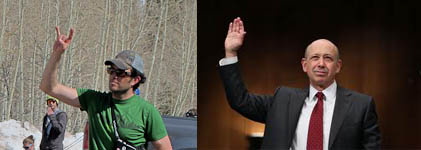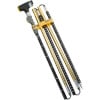7 – Hedge Fund Skiing
Part 7 of 10 in a series of personal avalanche avoidance theories.
After going on a financial disaster reading bender for the last three years, I started noticing a lot of similarities between investors and skiers:
- Risk versus Reward
- Smart people getting whacked
- Dumb people getting lucky
- Greed
- Herd instinct
- Competition
- Tons of underlying information available.
Perhaps the biggest similarity is that both financial markets and snowpacks are too complex and too connected to ever be able to forecast them with 100% accuracy. There will always be “one-in-a-million” events in both. Where they do differ is in the end result of getting it wrong – instead of getting bailed out and emerging richer than ever, with avalanches you die. It’s quite unfair.

Noah and Lloyd – aside from a few hundred million dollars, not really so different.
With this in mind, it is a good idea to always hedge your avalanche bets. The best way to do this is to develop excellent safe travel protocol (one at a time, spread out, don’t stop in run out zones, etc.) until they become ingrained habit. Safe travel habits have saved me many times that I know of, and many, many more that I don’t.

The elusive fat-tailed black swan. This slide took place during a backcountry safety class when 4-5 avalanche experts (including me) swore on a stack of AMGA Handbooks that you couldn’t buy an avalanche on that day.
Also, be conscious of being too greedy. If you’ve skied a bunch of great lines in a day, don’t push that dicey looking last one. Look at skiing as a lifelong investment, not a get rich quick scheme.
________________________________
Help support StraightChuter.com and push through the tranches with a Pieps IProbe One Probe ON SALE NOW from Backcountry.com. Click on the photo below…
Category: 07 Avalanche Avoidance










greed is more fun with fear
Yes you are very correct. All of the decision theory taught in MBA programs, especially around finance, is completely applicable to backcountry skiing and vice versa. Probabilities, biases, heuristic traps are all important. Escalation of commitment ( “we travelled a long way and worked hard to ski this slope. It’s has snowed another 6 in. since we started and 50 mph winds have been loading the slope, but we’re here…” ) is a vital one.
Really enjoying this series. Thanks for posting it up.
Also really enjoying this series. I think the analogy you make here in #7 is a really good one. The last bullet point on Tons of Underlying Information Available is a really good one – I find that much of safe travel is simply looking around at the available info, but it is quite easy to get tunnel vision. I try to constantly remind myself to take in the info and accept it for what it is.
Hi Jason – yes, that is always a kicker when it comes to expedition skiing. You spend all of this time, money and effort to get somewhere, and all that is separating you from the summit is a short section of exposed, windloaded terrain. Hmmmm. I remember a climber (Greg Child?) describing an exposed traverse on K2 as being “as hollow as a drum,” which is gut wrenching in terms of avalanche danger.
Nicely done. When I start thinking in terms of “one more” I know I should be on my way back to the car, not after this last, or in a while but now or even 10 minutes ago. And in groups I can never stand up for that feeling. I feel safer in a group but I’m probably a safer, more aware traveller by myself.
Right on. Reading the book, Black Swan really reinforced my thinking about avalanches. Always protect yourself against being caught on the wrong side of randomness. That’s why I keep preaching about the benefits of airbags and the comfort of low angled terrain.